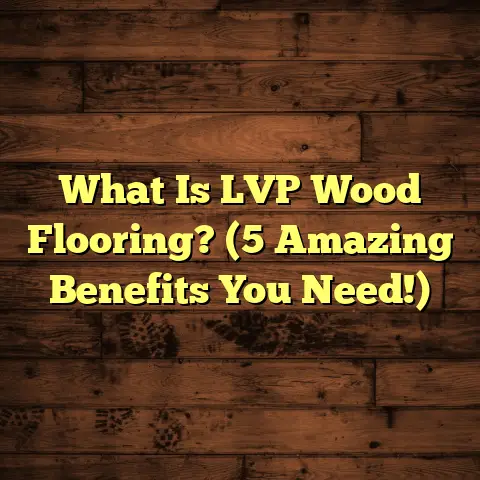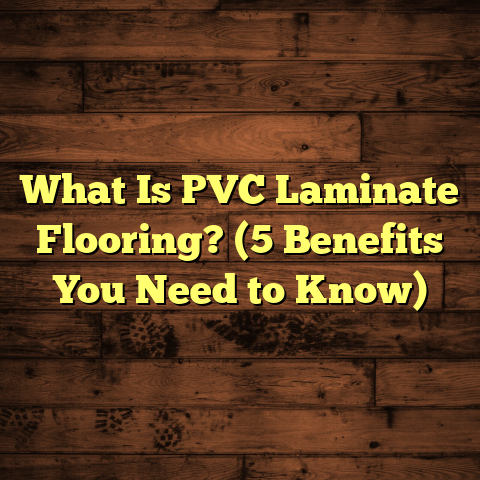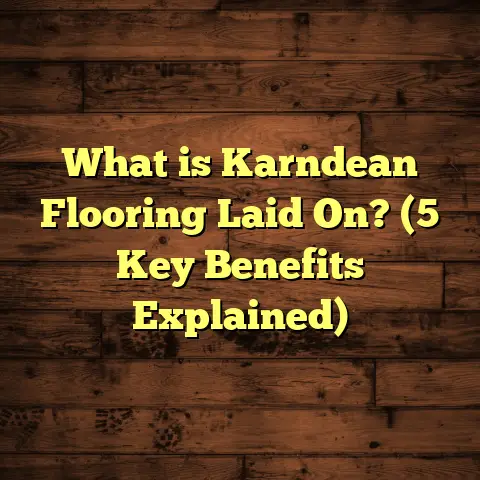What is VOC in Vinyl Flooring? (5 Key Facts You Should Know)
What is VOC in Vinyl Flooring?
VOC stands for Volatile Organic Compounds. When I first started working with vinyl flooring over a decade ago, the term VOC was one of those technical phrases that seemed to float around without much explanation. Back then, I didn’t fully grasp how important it was to understand what those chemicals meant for indoor air quality and for people living or working in spaces with vinyl floors. Over the years, after installing hundreds of thousands of square feet of vinyl flooring and working closely with manufacturers and environmental experts, I’ve learned that VOCs in vinyl flooring are a big deal—something every homeowner, contractor, or building manager should know about.
Simply put, VOCs are organic chemicals that evaporate at room temperature into the air. In vinyl flooring, they come from several sources: the plasticizers that make vinyl flexible, adhesives used to install the floor, inks or coatings applied on the surface, and other additives during manufacturing. When these compounds release into the air over time—a process known as off-gassing—they can affect indoor air quality and potentially impact health.
Let me walk you through what VOCs mean in the context of vinyl flooring, why it matters, and what you can do to minimize risks.
Why Does VOC Matter in Vinyl Flooring?
When I installed vinyl flooring in my own home’s basement years ago, I noticed this distinct chemical smell that lingered for nearly two weeks. It wasn’t just a mild odor—it was strong enough to make me wonder if I should have held off on using that product. Later, I learned that this smell was caused by VOCs being released into the air after installation.
Indoor air pollution is often overlooked but can be much worse than outdoor pollution. According to data from the Environmental Protection Agency (EPA), indoor air can be 2 to 5 times more polluted than outdoor air, largely due to VOCs emitted by building materials like flooring, paints, and adhesives. Some VOCs are harmless in small amounts, but others—like formaldehyde—are toxic and have been linked to respiratory problems, allergic reactions, headaches, and even cancer.
For families with children, elderly members, or anyone with asthma or chemical sensitivities, choosing low-VOC flooring isn’t just a preference—it’s a health necessity.
5 Key Facts About VOC in Vinyl Flooring You Should Know
1. VOC Levels Can Differ Dramatically Between Products
One of the biggest surprises for me was realizing how much VOC emissions vary between different vinyl flooring brands and types. Not all vinyl floors emit the same amount or type of VOCs.
For instance, luxury vinyl tile (LVT) from well-known manufacturers often undergoes rigorous testing to meet certifications like FloorScore or GREENGUARD Gold. These certifications limit total VOC emissions to under 50 parts per billion (ppb) for formaldehyde, with overall TVOC (total volatile organic compounds) kept extremely low.
In contrast, cheaper vinyl sheet flooring or no-name brands bought online can emit VOC levels exceeding 100 ppb initially—and sometimes they take weeks or even months to off-gas completely. Imagine installing a floor that causes headaches or dizziness for your family because it emits harmful chemicals for so long!
I always advise clients: ask suppliers for lab reports showing third-party testing of VOC emissions before buying vinyl flooring. If your project is in a state like California or Washington—which have strict air quality regulations—you might find it’s legally required to use only low-VOC certified products.
2. Off-Gassing Can Last Weeks or Months After Installation
The length of time VOCs remain airborne after vinyl flooring installation can surprise many people. The strongest off-gassing usually happens in the first 48–72 hours after installation when the floor is fresh. I remember a daycare center project in Chicago where we installed 1,200 square feet of vinyl planks.
Because kids are especially vulnerable to airborne pollutants, we ventilated the space continuously for two weeks using high-capacity fans and air purifiers. Even so, we monitored air quality regularly with handheld devices designed to measure formaldehyde and TVOC levels. It took nearly a month for emissions to drop near background levels considered safe by health authorities.
In your own home, if you’re installing vinyl flooring yourself or hiring contractors, try to arrange installation when you can keep windows open and fans running for several days afterward. If weather or security concerns prevent this, consider renting an air purifier with activated carbon filters.
3. Low-VOC Vinyl Flooring Costs More But Is Worth It
I get asked all the time: “Is low-VOC vinyl flooring really worth the extra cost?” From my experience both as a contractor and homeowner, the answer is yes—especially if you care about indoor air quality and long-term health.
Low-VOC floors certified by FloorScore or GREENGUARD Gold usually cost about $1.50 to $3 more per square foot compared to standard vinyl options. For example:
- Standard vinyl flooring installation: $2.50 – $5 per sq ft
- Low-VOC certified vinyl floors: $4 – $8 per sq ft installed
On a 1,000-square-foot project, that’s an additional $1,500-$3,000 up front. But when you consider potential health costs—doctor visits for respiratory issues or allergic reactions—and possible reinstallation costs if you need to replace a problematic floor later, it’s a smart investment.
In states with strict building codes like California’s Title 24 or New York City’s Local Law 97, only low-VOC materials are allowed in new construction or major renovations anyway.
4. Some VOCs Are More Harmful Than Others
Not all VOCs in vinyl flooring are created equal. Some are relatively benign odors; others pose serious health risks.
Formaldehyde is one of the most concerning VOCs found in some vinyl floor products. It’s classified as a human carcinogen by the International Agency for Research on Cancer (IARC). Even at low levels (measured in parts per billion), formaldehyde exposure can irritate eyes, nose, throat and exacerbate asthma symptoms.
Phthalates are another common group of VOCs found in vinyl flooring as plasticizers—they make the vinyl flexible and durable. Research has linked certain phthalates to hormonal disruptions and developmental problems in children.
When I worked on a hospital renovation project in Boston, we specified phthalate-free and formaldehyde-free vinyl flooring to protect patients with compromised immune systems. If you have young kids or anyone with chronic health issues at home, look specifically for products labeled “phthalate-free” or “no added formaldehyde.”
5. Installation Method Impacts VOC Emissions Greatly
I’ve learned from experience that how you install vinyl flooring can make a huge difference in VOC exposure after installation.
Traditional glue-down vinyl floors often require solvent-based adhesives that emit high levels of VOCs during drying. On one project in Dallas, switching from glue-down installation with solvent adhesive to a click-lock floating floor system (which requires no adhesive) significantly reduced off-gassing smells reported by occupants.
If you’re doing a DIY install or overseeing contractors:
- Choose dry-back or pressure-sensitive adhesives labeled as low-VOC or water-based.
- Consider floating vinyl planks or tiles that don’t require glue.
- Make sure installers ventilate the area well during and after installation.
My Personal Experience With VOC in Vinyl Flooring
Let me share a story from my own home renovation a couple of years ago. I was updating my kitchen floor with luxury vinyl planks because I wanted something waterproof but stylish and easy to clean. Initially, I picked a budget-friendly option based on price and looks alone.
The first few days after installation? The smell was intense—a strong chemical odor that made me worried about my young children playing nearby. I called the retailer who reassured me it was normal “off-gassing.” Still, I wasn’t comfortable leaving them in there all day.
So I ordered an indoor air quality monitor capable of measuring TVOCs and formaldehyde levels. The readings were sky-high initially—about 120 ppb total VOCs and 55 ppb formaldehyde—much higher than EPA recommended limits.
I ended up ripping out that floor after just three months because the smell never fully went away and my family experienced mild headaches when spending time in that room.
For my next kitchen renovation two years later, I spent more money on luxury vinyl plank certified by FloorScore with tested low VOC emissions. This time? No chemical odors at all—even right after installation. The air quality monitor showed TVOCs below 30 ppb immediately post-installation, dropping to near zero within a week.
This experience taught me never to compromise on indoor air quality when choosing flooring—especially vinyl—with families involved.
How Are VOCs Measured?
You might be wondering how professionals like me measure VOC levels during and after installation.
There are several ways:
- Laboratory Testing: Manufacturers send samples of their products to labs where they place them inside sealed chambers and measure emitted VOCs over time using gas chromatography-mass spectrometry (GC-MS). These tests produce standardized data that support certifications like FloorScore.
- Handheld Monitors: On job sites, I use portable indoor air quality monitors that detect total VOCs (TVOCs) and specific compounds like formaldehyde in parts per billion (ppb). These devices give real-time feedback so I know when ventilation is sufficient or if additional measures are needed.
- Long-Term Sampling: For sensitive projects—like schools or hospitals—long-term passive samplers may be deployed over weeks to track VOC levels continuously.
Understanding Relevant Standards & Certifications
If you want peace of mind when selecting vinyl flooring regarding its VOC content, look for these certifications:
- FloorScore: A widely recognized certification by SCS Global Services focusing on low indoor emissions from floor coverings including vinyl. Products must meet strict limits on TVOCs and formaldehyde emissions.
- GREENGUARD Gold: This certification means the product meets stringent chemical emissions limits set by UL Environment for healthier indoor air quality.
- California Air Resources Board (CARB) Phase 2: Regulates formaldehyde emissions from composite wood products but has indirect effects on some flooring materials sold in California due to strict state laws.
How Weather & Geography Affect VOC Off-Gassing
You might not think about it much, but where you live affects how quickly VOCs dissipate after installing vinyl floors.
In warmer climates like Florida or Texas, higher temperatures cause faster evaporation of VOCs—meaning off-gassing peaks sooner but usually lasts a shorter period (a few days). However, humidity can trap some compounds indoors longer unless ventilation is good.
In colder climates such as Minnesota or Canada, colder temperatures slow down off-gassing but also mean homeowners keep windows closed more often during winter months—so indoor VOC concentrations might remain elevated longer without mechanical ventilation.
So if you live somewhere cold during your install season (fall/winter), plan for extra ventilation using fans or portable air purifiers indoors after installation finishes.
Cost Breakdown: How Much Does Low-VOC Vinyl Flooring Really Cost?
Here’s some data based on projects I’ve completed across different states:
| Item | Price Range (USD) | Notes |
|---|---|---|
| Standard Vinyl Flooring | $2.50 – $5 per sq ft installed | Lower upfront cost but higher VOC risk |
| Low-VOC Certified Vinyl Flooring | $4 – $8 per sq ft installed | Includes FloorScore/GREENGUARD products |
| Adhesives (Solvent-Based) | $0.50 – $1 per sq ft | Higher VOC emission risk |
| Low-VOC/WB Adhesives | $1 – $2 per sq ft | Safer alternative |
| Air Purifier Rental | $50 – $150 per week | Useful for reducing indoor VOC post-install |
On average, budget an additional 25-40% more if you want certified low-VOC floors combined with low-emission adhesives and ventilation equipment rentals during install.
Common Myths About VOCs in Vinyl Flooring
Myth #1: “If It Smells Strongly It Must Be Dangerous”
A strong chemical odor usually means high initial off-gassing but doesn’t always mean dangerous levels long-term. Some people are more sensitive and perceive odors more intensely than others.
However, persistent odor beyond several weeks could indicate problematic product choice or improper ventilation.
Myth #2: “All Vinyl Flooring Has High VOCs”
Not true! Many manufacturers produce ultra-low-VOC options tested by independent labs with emissions well below health-based guidelines.
Myth #3: “Once Installed There’s Nothing You Can Do About It”
Actually, you can reduce exposure by ventilating thoroughly post-installation using fans/windows or running air purifiers indoors equipped with activated carbon filters specifically designed for chemical removal.
Troubleshooting High VOC Issues After Installation
If you notice strong odors or symptoms like headaches/dizziness after installing vinyl floors:
- Increase Ventilation: Open windows and use fans continuously for several days.
- Use Air Purifiers: Get units with activated carbon filters rated for VOC removal.
- Check Adhesives: If glue-down method was used with solvent adhesives consider partial removal.
- Test Air Quality: Use handheld monitors or hire professionals for testing.
- Contact Manufacturer: Sometimes product recalls or replacements are necessary if emissions exceed safe limits.
From my experience fixing such issues on client jobsites costing thousands extra in remediation efforts—it’s better to prevent rather than cure!
Final Thoughts: Making Smart Flooring Choices
Choosing vinyl flooring today means balancing style preferences with health considerations related to VOC emissions. While low-cost options tempt buyers initially, investing in certified low-VOC products along with proper installation methods will save money and health down the road.
If you want personalized help calculating costs based on your local labor rates and material prices plus waste factors—tools like FloorTally are excellent resources to get realistic budgeting estimates quickly without chasing multiple quotes.
Remember: good ventilation during and after install plus choosing low-VOC certified products equals better indoor air quality—and happier homes!
Feel free to ask if you want help picking specific brands or need step-by-step installation advice tailored for low-VOC solutions!





